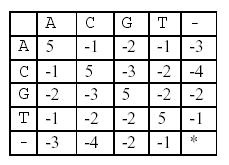hdoj-1503-Human Gene FunctionsLCS的变形
Posted ljbguanli
tags:
篇首语:本文由小常识网(cha138.com)小编为大家整理,主要介绍了hdoj-1503-Human Gene FunctionsLCS的变形相关的知识,希望对你有一定的参考价值。
Human Gene Functions
Time Limit: 2000/1000 MS (Java/Others) Memory Limit: 65536/32768 K (Java/Others)Total Submission(s): 2723 Accepted Submission(s): 1538
A human gene can be identified through a series of time-consuming biological experiments, often with the help of computer programs. Once a sequence of a gene is obtained, the next job is to determine its function. One of the methods for biologists to use in determining the function of a new gene sequence that they have just identified is to search a database with the new gene as a query. The database to be searched stores many gene sequences and their functions – many researchers have been submitting their genes and functions to the database and the database is freely accessible through the Internet.
A database search will return a list of gene sequences from the database that are similar to the query gene. Biologists assume that sequence similarity often implies functional similarity. So, the function of the new gene might be one of the functions that the genes from the list have. To exactly determine which one is the right one another series of biological experiments will be needed.
Your job is to make a program that compares two genes and determines their similarity as explained below. Your program may be used as a part of the database search if you can provide an efficient one.
Given two genes AGTGATG and GTTAG, how similar are they?
One of the methods to measure the similarity of two genes is called alignment. In an alignment, spaces are inserted, if necessary, in appropriate positions of the genes to make them equally long and score
the resulting genes according to a scoring matrix.
For example, one space is inserted into AGTGATG to result in AGTGAT-G, and three spaces are inserted into GTTAG to result in –GT--TAG. A space is denoted by a minus sign (-). The two genes are now of equal length. These two strings are aligned:
AGTGAT-G
-GT--TAG
In this alignment, there are four matches, namely, G in the second position, T in the third, T in the sixth, and G in the eighth. Each pair of aligned characters is assigned a score according to the following scoring matrix.

* denotes that a space-space match is not allowed. The score of the alignment above is (-3)+5+5+(-2)+(-3)+5+(-3)+5=9.
Of course, many other alignments are possible. One is shown below (a different number of spaces are inserted into different positions):
AGTGATG
-GTTA-G
This alignment gives a score of (-3)+5+5+(-2)+5+(-1) +5=14. So, this one is better than the previous one. As a matter of fact, this one is optimal since no other alignment can have a higher score. So, it is said that the similarity of the two genes is 14.
2 7 AGTGATG 5 GTTAG 7 AGCTATT 9 AGCTTTAAA
14 21
#include<stdio.h>
#include<string.h>
const int inf=-1<<20;
int c[5][5]={
5,-1,-2,-1,-3,
-1,5,-3,-2,-4,
-2,-3,5,-2,-2,
-1,-2,-2,5,-1,
-3,-4,-2,-1,inf
};
int max(int a,int b){
return a>b?a:b;
}
int f(char x){
if(x==‘A‘) return 0;
if(x==‘C‘) return 1;
if(x==‘G‘) return 2;
if(x==‘T‘) return 3;
else return 4;
}
int a[110],b[110],dp[110][110];
char s1[110],s2[110];
int main(){
int t;
scanf("%d",&t);
while(t--){
int i,j,n,m,x,y;
scanf("%d ",&n);
gets(s1+1);
for(i=1;i<=n;++i){
a[i]=f(s1[i]);
}
scanf("%d ",&m);
gets(s2+1);
for(i=1;i<=m;++i){
b[i]=f(s2[i]);
}
memset(dp,0,sizeof(dp));
for(i=1;i<=n;++i) dp[i][0]=dp[i-1][0]+c[a[i]][4];
for(i=1;i<=m;++i) dp[0][i]=dp[0][i-1]+c[4][b[i]];
for(i=1;i<=n;++i){
for(j=1;j<=m;++j){
dp[i][j]=max(dp[i-1][j-1]+c[a[i]][b[j]],max(dp[i-1][j]+c[a[i]][4],dp[i][j-1]+c[4][b[j]]));
}
}
printf("%d\n",dp[n][m]);
}
return 0;
}
以上是关于hdoj-1503-Human Gene FunctionsLCS的变形的主要内容,如果未能解决你的问题,请参考以下文章